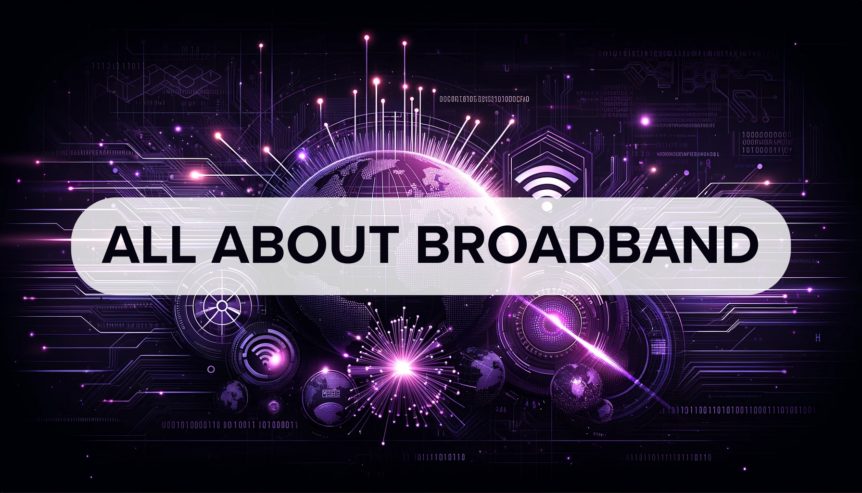Live Updates Thank you to all that attended our Annual Meeting this last Saturday!

All About Broadband
All About Broadband
Broadband internet has transformed how we access and share information. This high-speed internet service, transcending traditional dial-up limitations, is integral to various aspects of our lives, from personal to professional. Let’s delve into the essential aspects of broadband internet, answering some questions about its nature and capabilities.
What is broadband?
Broadband internet works by transmitting data over various types of networks. The type of broadband connection you have determines how data is sent and received. For instance, DSL uses existing telephone lines without interrupting telephone use. Cable broadband utilizes the same lines that deliver cable television, offering high-speed internet access alongside TV services. Fiber-optic broadband, which is known for its exceptionally high speeds, uses strands of glass fibers to transmit data as light signals. Wireless broadband connects homes and businesses to the internet using radio signals instead of cables, while satellite broadband employs satellites to beam internet signals to a dish installed at the user’s location. Each of these technologies facilitates the rapid transmission of data, but they differ in terms of installation, speed, availability, and cost.
How does broadband internet work?
The concept of broadband began to take shape in the late 1990s, with the introduction of DSL and cable modem services. These technologies marked a significant leap from the slow dial-up connections that had been the standard since the early days of the internet. In the years that followed, broadband technology evolved rapidly. The early 2000s saw the advent of fiber-optic broadband, which offered unprecedented speeds, revolutionizing internet connectivity. Satellite and wireless broadband options also emerged, expanding internet access to remote and rural areas that previously had limited connectivity options. The evolution of broadband has been a key driver in the global digital revolution, enabling a wide range of online services and applications.
When did broadband come out?
Broadband internet is highly beneficial for a multitude of reasons. It provides high-speed internet access, which is crucial for efficient web browsing, streaming of high-definition video and music, fast download and upload speeds, and smooth performance of online games and services. Broadband is also essential for modern businesses, enabling faster communication, efficient cloud-based services, and the seamless operation of web-based applications. For households, it supports multiple devices connected simultaneously without significant loss in performance. Additionally, in educational and healthcare settings, broadband facilitates remote learning and telehealth services, respectively. While there may be variations in performance based on the type of broadband and geographical location, the overall impact of broadband on improving internet accessibility and efficiency is undeniable.
Is broadband good?
Broadband internet is highly beneficial for a multitude of reasons. It provides high-speed internet access, which is crucial for efficient web browsing, streaming of high-definition video and music, fast download and upload speeds, and smooth performance of online games and services. Broadband is also essential for modern businesses, enabling faster communication, efficient cloud-based services, and the seamless operation of web-based applications. For households, it supports multiple devices connected simultaneously without significant loss in performance. Additionally, in educational and healthcare settings, broadband facilitates remote learning and telehealth services, respectively. While there may be variations in performance based on the type of broadband and geographical location, the overall impact of broadband on improving internet accessibility and efficiency is undeniable.
What are the speeds of broadband internet?
The speeds of broadband internet can vary significantly based on the technology used and the service provider. DSL, one of the earliest forms of broadband, typically offers speeds ranging from 1 to 100 Mbps. Cable broadband, which uses the same infrastructure as cable TV, often provides higher speeds, ranging from 10 Mbps to over 1 Gbps. Wireless and satellite broadband speeds can be more variable, generally ranging from 10 Mbps to 100 Mbps, depending on factors like signal strength and line of sight to the transmitter or satellite. It’s important to note that these speeds represent the maximum capabilities of each technology and actual speeds may be lower due to various factors like network congestion and distance from the service provider.
How do I access my broadband?
Accessing broadband internet depends on the type of connection you have. For DSL and cable broadband, you will typically need a modem connected to your phone line or cable outlet, respectively. Many providers offer a combined modem-router unit, or you can purchase your own. For fiber-optic broadband, an optical network terminal (ONT) is required to convert the fiber-optic light signals into electrical Ethernet. This ONT is usually installed by the service provider. Wireless broadband requires a wireless router, which receives the signal from your ISP and creates a Wi-Fi network. For satellite broadband, you need a satellite dish installed at your location, which communicates with a satellite in orbit. Once your hardware is set up, you can connect your devices either wirelessly via Wi-Fi or through Ethernet cables. It’s always recommended to secure your network with a strong password to prevent unauthorized access.
Ready to get started with TruLeap?
If you are a resident of Twin Falls county, we can provide you with high-speed wired or wireless broadband service! If you would like to learn more or make the switch to one of Southern Idaho’s most trusted internet service providers, give us a call today!
